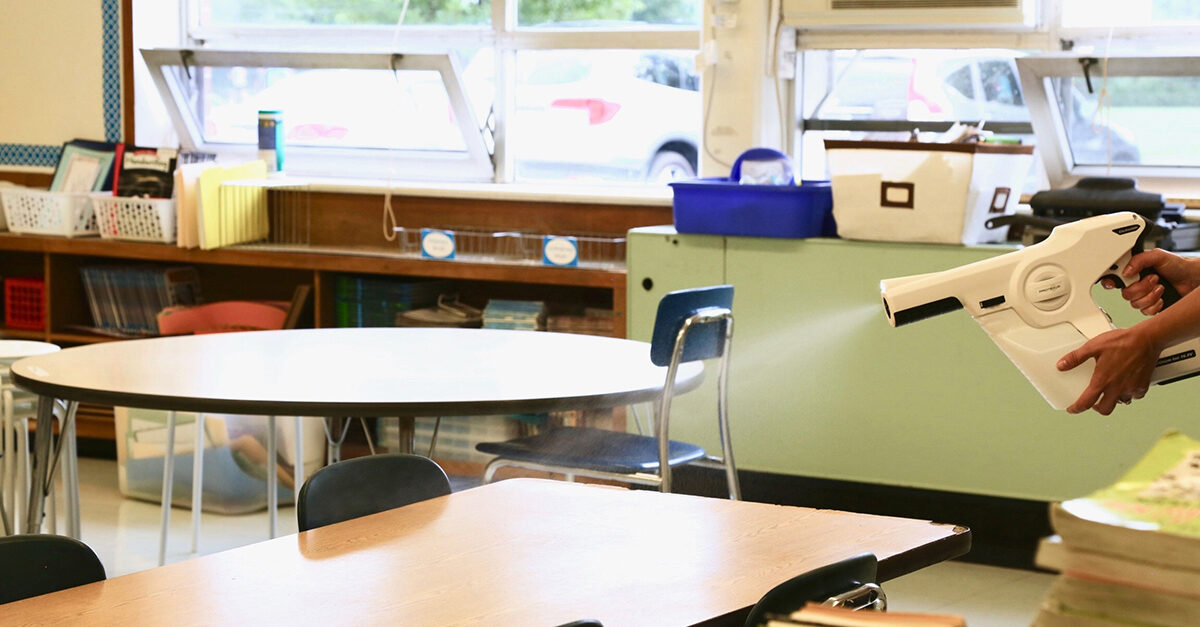It’s becoming more difficult for facilities to stay ahead of today’s rising public health threats and increasing demands for higher levels of disinfection. Managers and service providers are challenged with improving outcomes, yet in a limited timeframe without increasing budgets or staff. The advent of advanced electrostatic technologies offers facilities new ways to achieve greater efficiencies and better outcomes.
Newfound efficiency
Traditional disinfection methods can leave a large percentage of surfaces untouched. However, when electrostatics are used in place of—or in addition to—wipes, trigger sprayers, or mops, a single team member can disinfect the same area that normally required a staff of five. This newfound efficiency enables facilities to increase disinfection frequency, which is crucial to preventing the spread of emerging viral pathogens.
Electrostatic sprayers also achieve three times the coverage of a traditional spray bottle due to positively charged disinfectant droplets, which magnetically attract to and wrap around target surfaces. Not only can users expedite the disinfection processes, they also can eliminate virtually all infectious fungi, viral particles, and bacteria from every surface.
Electrostatic options
Over the last several years, electrostatic sprayer technologies have evolved significantly and are now easier to use for disinfection purposes. Types of equipment range from handheld sprayers and self-contained backpacks to variations of rolling cart systems, or a combination thereof. Some versions are battery-powered, while others are corded, but both are designed to positively charge the liquid solution. Battery-powered sprayers remove the potential for cord-related accidents and allow freedom of movement without being tethered to an outlet. In the past, users questioned whether batteries were strong enough to deliver consistent electrostatic application compared to cords connected to a power source. However, today’s high-performance, portable sprayer technologies are more than powerful enough to coat every surface completely and evenly.
When comparing electrostatic equipment options, ensure they are ETL or UL certified by Nationally Recognized Testing Laboratories (NRTL) to confirm they meet the U.S. Occupational Safety and Health Administration’s (OSHA) safety standard requirements. Also make sure the equipment comes with clear guidelines to help staff use the system responsibly and with the proper disinfectant chemistries.
Electrostatic merits
Although electrostatic disinfection is on the rise, users are just beginning to realize its merits for improving disinfection outcomes. Many facilities are already seeing dramatic drops in labor costs and expenses due to faster disinfection times and triple surface coverage per ounce. In a matter of minutes, workers disinfect entire areas with just a quick pass of the electrostatic device over potentially contaminated surfaces.
Additionally, many safety benefits are associated with electrostatic disinfection processes. Applying chemicals in a more uniform and controlled manner removes the dangers of overuse and reduces waste and chemical use by as much as 60% per square foot.
Desktops, computers, and other equipment can be safely disinfected by applying noncorrosive and compatible chemistries with electrostatic sprayers. These sprayers can also help eliminate odors at their source, control pests, and make mold remediation faster and more cost-effective.
Undoubtedly, the most valuable benefit is the ability to proactively prevent the spread of infectious viruses. Because electrostatic application is touchless, there’s no risk for cross-contamination, whereas microfiber towels or wipes can potentially transfer microbes from surface to surface.
Industry-wide applications of electrostatic technologies
Some facilities substitute electrostatic sprayers for manual disinfecting methods, while others use them to augment existing processes. Myriad different approaches are being field tested in cleaning protocols for schools, hospitals, senior living centers, offices, buildings, kitchens, restaurants, gyms, and many other types of facilities. Use of electrostatic disinfection has also begun to proliferate in public transportation, airlines, and rental car businesses, as well as in highly populated environments like stadiums, amusement parks, cruise lines, and more. As electrostatic technologies continue to evolve, they will soon become economical enough for almost anyone to afford.
Electrostatic uses are also being developed for other applications like biological contamination. Recently, the U.S. Environmental Protection Agency (EPA) conducted an evaluation of electrostatic sprayers for personnel decontamination during incident response operations. The EPA determined this technology could reduce the risk of cross-contamination among field personnel and equipment, as well as minimize additional exposure risks. Results also suggested electrostatic sprayer technologies could offer significant operational cost savings with much less chemical waste.
Looking forward
Trends clearly indicate wide-scale adoption of electrostatic sprayers is imminent. Nonetheless, long-term success is contingent on adhering to industry standards for compliant use of the technologies. Only then can facilities leverage the full scope of its efficiencies, vastly enhanced disinfection processes, and ability to improve outcomes.



